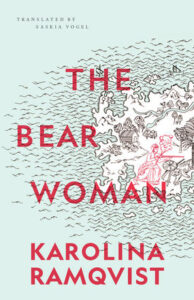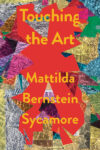
[Coach House Books; 2022]
Tr. from Swedish by Saskia Vogel
On the cover of Karolina Ramqvist’s novel The Bear Woman is the partial image of a drawing, which seems to be a map of a small island in some waves. We see trees and bushes, rocks and hills, a winding stream, a little wooden house, and the lone figure of a woman, who seems to have just shot a gun. This figure, later identified as Marguerite de la Rocque, a 16th-century French noblewoman stranded on an empty island somewhere in the Gulf of St. Lawrence, occupies the center of the novel, and telling the story of her life, obscured by the distances of time and purposeful erasure, is the unnamed narrator’s fixation. What she does manage to tell, both of her own story and that of de la Rocque, is done through a mixture of lucidly detailed narrative and engagingly discursive meditations on a range of interwoven themes, from writing to womanhood, memory to social media. The novel is also a work of ekphrasis, as it explores the complex relationships between looking, writing and obsession, between seeing and being seen, and between word and image. If it is this drawing of de la Rocque that first stirs the narrator to disclose her story, then it seems that only through the act of writing can she get rid of the image and at last close her eyes.
The narrator, who lives with her partner and children somewhere in contemporary Northern Europe, first hears about de la Rocque from a friend. Even then, she says, from the beginning, she could see an image in her mind of the small island. When she first discovers the historic map (the one shown on the cover) in a book about de la Rocque, her fixation grows in tandem with her bafflement:
In the midst of all of this I found the drawing, enlarged on a full page of its own. I didn’t understand what it was . . . What I saw on the page with the illustration was a blackish-grey muddle of indecipherable shapes and marks shooting off in all directions, scratches and lines . . . I couldn’t interpret the image, but neither could I stop looking.
Only in time, as with an optical illusion, does the meaning of the lines and blotches slowly show itself, until “one afternoon, as I sat in bed with the image open on the computer, her figure appeared in its entirety and I saw her plain and clear.”
What it is the narrator knows and sees is not always made explicit, and much of the novel takes its structure from the drama of slowly revealing the story before and after de la Rocque’s abandonment. At first the drawn-out pace frustrated me, and when my concentration lagged, I found myself jumping online to google de la Rocque and skimming the first few paragraphs of wikipedia to fill in the details of the story. At the same time, I felt a strange guilt for not trusting the novel or the narrator. Thankfully my guilt or patience won out, and it soon occurred to me that my very dismay matched that of the narrator herself, who also seems to struggle constantly, not only with being distracted by her smartphone but also wanting the comfort of substantial fact.
After some research, she finds three primary texts, written during or just after de la Roque’s life, including histories by André Thevet and François de Belleforest and the short tales of Marguerite de Navarre’s Heptaméron. At least two of these authors seem to have met or known de la Rocque. And yet most of the substance of her life is lost or obscured by a persistent fog:
They could have answered several of my questions, but in these books the answers were hidden in rewritings, fictionalizations, and omissions of central facts. There were silences, omissions and lies, romanticization and literary conceits. They each had their own motives for why they had chosen to tell her story at all, and for how they told it. Their own urges and fears permeated these works. In this respect we were no different.
Here the parallels between myself-as-reader and the narrator take on a raised texture: just as I perceived omissions and conceits in her narration, so does she find the same in her research, and in the same way that she conceives of those authors’ motives, so do I find myself focusing on her urges and fears, which saturate the novel and are brought into sharp focus by this doubling.
Many of her fears are linked explicitly to writing and research. Having spent much of her time online looking up images or reading about the 16th century, she begins to fear knowing too much: “I didn’t google [de la Rocque] right away,” she says, not wanting to spoil it; instead, she fills up notebooks with post-its, “only to tear them out and toss them away.” She feels the urge to instead become “one with the facts,” growing so immersed that de la Rocque’s story would simply arise in her, as if to bring her back out of oblivion. But her hesitance to research also seems like an avoidance tactic, to keep her from having to write about certain specific difficulties in de la Rocque’s story. If she cannot face these, neither can she look away. One night, a dinner party guest mentions a nudist camp in the same city as where de la Rocque’s relative was born; and later she checks into a hotel, unconscious of the fact that it was modeled after that same relative’s castle. “Was this another sign?” she asks, “Was I a fool searching for signs and thinking I was seeing them everywhere?”
I am interested in how the book relates the act of looking, consciously and not, with writing and obsession. Although ekphrasis is frequently seen as a process for unpacking the object that one looks at (usually a work of art), it can also function as a mirror, to explore the subject that is looking, since the things we see, and notice, can reveal a lot about our own interiority and its impulses. In the book, the narrator often moves between descriptions of what she is seeing in the world and the pictures that she carries in her mind, which had come to her, she writes, like “flashes of light through the darkness of my existence.”
The visual references in the book — from the map described above to oil paintings of 16th-century French kings and queens; from a dried, brittle leaf she keeps by her desk to vines of ivy winding up a castle wall — become something like constellations, guiding her not just through her own despair but also through the darkness of de la Rocque’s narrative. Indeed, her first idea was to produce a TV script, as if the story would be better expressed visually. As she visits places connected to her subjects’ life, the narrator tries using a camera, as if to capture and make sense of an experience she cannot put into language:
I took a few pictures of the greenery being the walls and was gripped by a desire to find out what types of plants they were, to photograph each one I saw, so that when I got home I could determine which plants had been around back then, which ones she could have seen and touched and smelled. Ivy climbed over the wall and up the tower; between the stones grew stonecrop; and from the mortar rose slender blood-red flowering stalks.
In the end, however, language wins; the camera, she realizes, is just another boundary between her and what she came to see. By the time she gets home, she thinks, “I wouldn’t want to look at the pictures, I’d just want to write.”
Writing, of course, can be another way of putting off, of making a boundary, and much of the novel is taken up with reflections on its limits and releases. Building a book around the difficulties of the writing life is a familiar move — I think of Kate Zambreno’s Drifts, another recent autofiction novel with a narrator struggling through a literary project that becomes the book itself — but Ramqvist’s excavation of the process of creation and research, delay and anxiety, is both multi-layered and intriguing. What engages me is not just her meditations, but also the repeated turning outward, toward the visual. Indeed, writing is explicitly connected to a self-conscious, gendered gaze: “It had been a way to not have to be a woman: to look, instead of being looked at. In this way I could, without repercussion, and sometimes unseen, access certain spaces, physical or emotional spaces, spaces of experience—without really having to be there.”
In the end she does manage to access de la Rocque’s life — against her own reluctance or digressions, missing records or the machinations of sinister figures from the past — and presents a vivid portrayal that stays self-conscious of the play between fact and speculation. The struggle in “seeking out neglected female fates and trying to revive them” carries its own complexities. But at least it seems to me, part of the narrator’s response to the elusiveness of de la Rocque’s life is to insist on her own being and experience, as if to leave the kinds of records de la Rocque could or would not. This work is done in writing, in language (e.g., the book), but this writing is still guided by and haunted with pictures, images, visual patterns. Reflecting on the family photographs she’s taken while raising her children, the narrator offers a description that could equally apply to the novel itself, taking them “to catch the passing moments, but also to confirm that, yes, I was actually there.”
James Scales is a writer and artist based in New York City’s oldest house. His writing has appeared in Kenyon Review and Yes Poetry, and is forthcoming with The Hopkins Review.
This post may contain affiliate links.







